
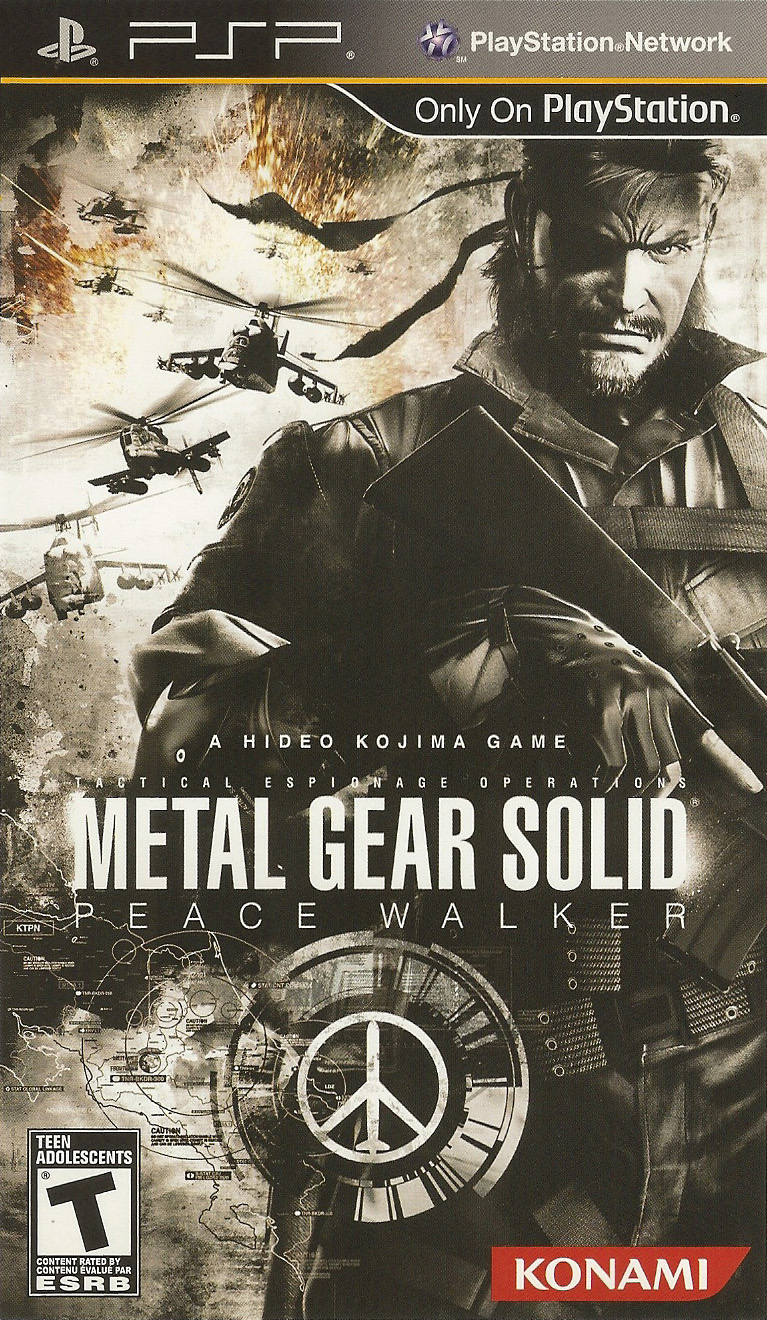 |
Metal Gear Solid: Peace Walker
Developer: Kojima Productions |
Kojima Productions had worked throughout the lifespan of the PSP, churning out titles for it every few years between its launch in North America in 2005 and then finally in 2010 during the platform’s twilight years. Building on the knowledge they learned with each game they released on the handheld system, Kojima Productions’ last game for it would be their greatest, but not only for their own games designed specifically for the PSP, but one of the greatest games for the portable console itself.
With this installment of the Metal Gear Solid series, Hideo Kojima takes the helm by becoming the Writer, Director, and Producer; the similar trifecta of roles he normally takes, but passed on during Portable Ops where he was only the Producer. And when compared to Portable Ops, Peace Walker is head and shoulders above its predecessor in every way possible.
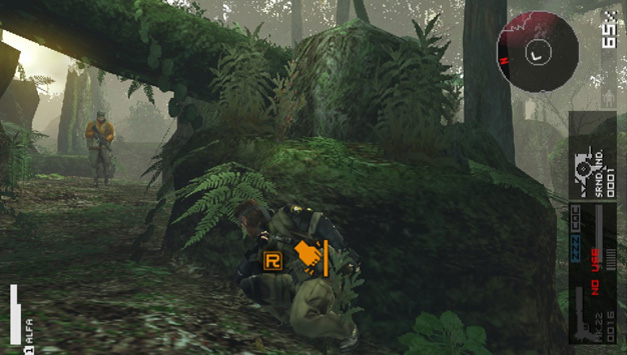
The story for Metal Gear Solid: Peace Walker takes place a few years after the event from Portable Ops during the 1970s. Big Boss -- using his code name Snake from previous games like Snake Eater and Portable Ops -- is now the leader of a group called Militaires Sans Frontières, which is comprised of soldiers who’ve come from nations all over the world. Snake accepts a job from a client that needs to find out why a highly organized military group has entered into Costa Rica and setup operations there. In return for his services, Snake and his group are given an offshore facility and a helicopter where they can use as a base for MSF.
Including in Peace Walker once again is the base building gameplay we saw introduced with Portable Ops, however the importance of building your base has a larger impact than it did before. Returning are the skills each soldier can possess which you can assign to various teams like the Engineering Team for R&D related jobs, or the Mess Hall to boost the morale for everyone which in turn increases productively. The biggest improvement has been in streamlining the process of “recruiting” soldiers where instead of knocking them out and dragging their limp bodies across a level to a truck, you can now use a Fulton recovery system to instantly send them into the air via a balloon and having a helicopter recover and then send them to MSF’s home base.
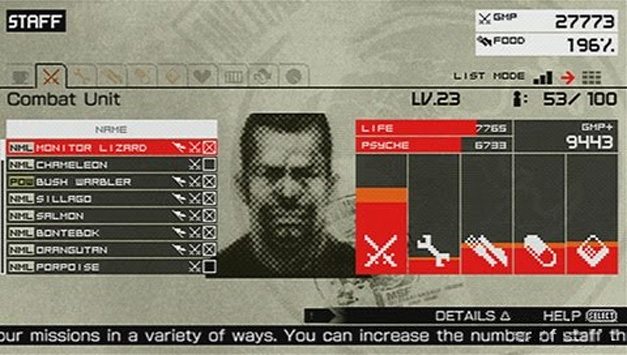
The true beauty of this game is how it breaks down missions into short, bite-sized objectives that you select from a list that generates as you progress through the story mode, making this a perfect companion for on-the-go gameplay. In addition to the story based missions are side ones labeled as Extra Ops. They include a number of objectives that help in building you base’s arsenal of weapons, recruit more solders, or assist in increasing the stats of soldiers, making each one stronger in their field of expertise which in turn helps in making your base that much stronger. Later on you can deploy your soldiers to conflicts around the world in a mode called Outer Ops that tests how well you’ve built them up. Rewards for accomplishing these missions include collecting ammo and getting access to documents which help the Engineering team design better weapons.
Oh, right. RPG elements have been added to the weapons system. Just collecting weapons won’t cut it anymore as later missions will have enemies that are harder to kill. All weapons and items have a leveling system. The more you use them, the more they will level up to cap of 3. Once that happens, you will have to find documents hidden within levels to help the Engineering team increase the weapon’s or item’s power to a new ranking level, but the documentation alone won’t do as the experience of the Engineering team will have to be high enough so they can understand and use the documents. Starting to see how everything is tied to one another?
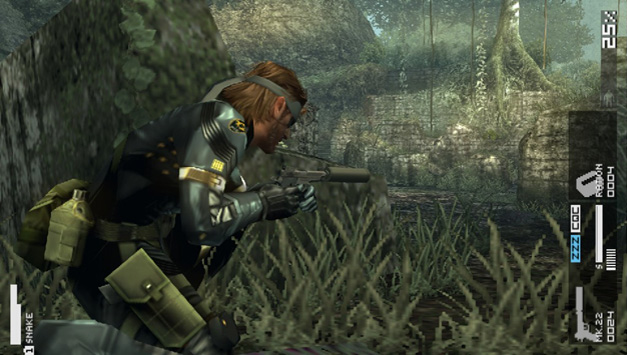
Despite the PSP’s shortcomings of graphics and processing power compared to its sibling the PS2, the gap was narrowed considerably with Peace Walker, bringing everything up to par of what you would have seen from Snake Eater for the PS2. Contrasting the simpler, straight-lined level designs seen in Portable Ops where you spent most of the time sneaking around military locations that include objects being of squared liked designs such as buildings, shipping crates, vehicles, and perimeter walls; Peace Walker takes place in environments that are thick in nature. Foliage is high, almost everywhere, and makes it difficult to sometimes spot enemy soldiers lying low in the brush. The uneven surfaces of nature adds to the scenery, making the level deigns look more organic. Parallels can be seen between Portable Ops and Peace Walker like the changes seen between MGS2 and MGS3. With MGS2, levels are man-made structures built with steel and concrete while MGS3 dumps you in a swampy region full of trees, rivers, and animals.
Returning for the illustrated cutscenes is comic book artist Ashley Wood’s unique style of sketch drawings. Improvements have been made to these where instead of having captions at the bottom of the screen, every spoken word is placed within word bubbles that appear and disappear when dialog occurs; bringing the digital comic experience in full effect. But in addition to the digital comics aesthetic, cutscenes are also rendered in-engine which include a great number of details like having characters blink their eyes or moving their mouths when they speak.
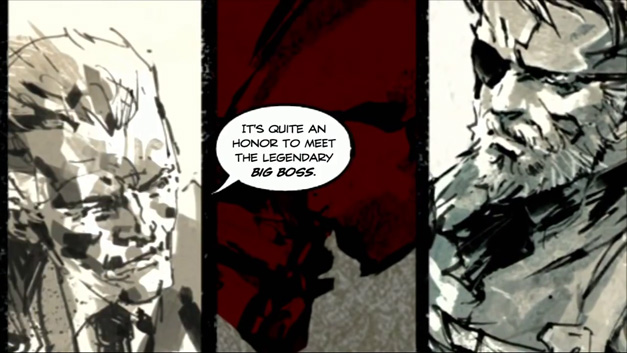
The story mode itself won’t take too long to accomplish. Of course with it being a Kojima game, there are a number of lengthy cutscenses that total over a few hours’ worth -- which thankfully you can rewatch later from a menu that lists all of the cutscenes -- but once the story mode has been completed, there’s still a lot more you can do. Supplementing the story are bits that you can discover by progressing forward with Extra Ops and completing all of the missions. You’ll need to have some patience as there are well over a hundred of them! As the motivation for propelling you forward, the game has a carrot and stick technique where not everything for the story is revealed once after completing all of the missions. You’ll discover audio tapes hidden throughout some of the missions that help act as a prologue of sorts.
If you want to complete all of the Outer Ops missions, then Extra Ops is a definite tool needed for completing this task, but as an incentive, going through Outer Ops helps in strengthening your base and equipment. The big caution here is that Outer Ops is where you can lose soldier and vehicles during combat. If a soldier’s life drops to zero and they are relatively weak, then they might not make it, permanently losing that soldier and all the stats tied to him. The same goes for vehicles. If the life bar for one reaches zero, then it will be beyond repairing and you’ll have to go into Extra Ops and retrieve another one. All of this peppers in a bit of risk and reward to the gameplay.
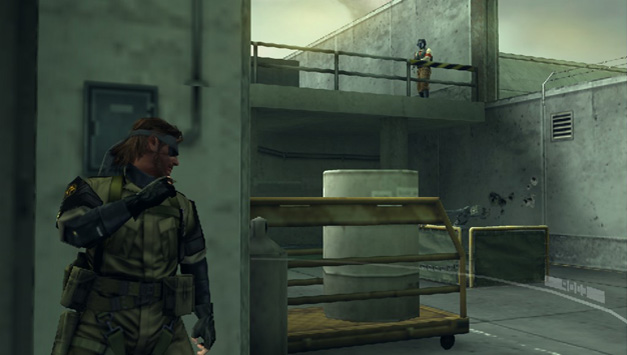
Keep going forward and more secrets will be revealed, with the craziest one being a cross over between Metal Gear Solid and Monster Hunter. So yeah, there’s a lot going on in Peace Walker, way more than your typical MGS game. Between the three modes, it will keep you busy for a while. Sure, there will be level grinding to do and at times be very repetitive (especially when retrieving new vehicles), but at a certain point your weapons and items will have been upgraded high enough that even the toughest missions will become a walk in the park.
It’s hard not to recommend Peace Walker enough. My playthrough was with the PSP, but it has since been ported to a number of platforms to fit the preferred preferences of most gamers. For the PS3 and 360, it’s included with the Metal Gear Solid HD Collection, allowing you to play on a big screen TV with a controller with more buttons to spread the control scheme across. But if you prefer to play it on the go, then it can be played on the Vita too, but with the benefit of having two analog sticks instead of just one on the PSP, making the camera controls easier to manage. With a game that includes a healthy amount of both quality and quantity for its gameplay, Peace Walker is a worthwhile title for the Metal Gear Solid saga.
Image credits: IGN, Hooked Gamers
Posted on: May 25, 2016
